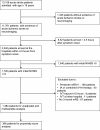Comparative effectiveness of standard care with IV thrombolysis versus without IV thrombolysis for mild ischemic stroke
- PMID: 25628404
- PMCID: PMC4330057
- DOI: 10.1161/JAHA.114.000596
Comparative effectiveness of standard care with IV thrombolysis versus without IV thrombolysis for mild ischemic stroke
Abstract
Background: One third of patients presenting with initially mild strokes have unfavorable outcomes, and the efficacy of intravenous thrombolysis (IVT) in this population has not been proven. This study aimed to evaluate the comparative effectiveness of standard care with IVT versus without IVT in mild stroke patients.
Methods and results: Using a multicenter stroke registry database, we identified patients with acute ischemic stroke who presented within 4.5 hours of symptom onset and had initial National Institutes of Health Stroke Scale scores ≤5. Multivariable logistic analysis and propensity score matching were used to adjust for baseline imbalances between the patients who did and did not receive IVT. Adjusted odds ratios and 95% CIs of IVT were estimated for 3-month modified Rankin Scale scores of 0 to 1 and symptomatic. Of 13 117 patients with stroke who were hospitalized between April 2008 and May 2012, 1386 met the eligibility criteria, and 194 (14.0%) were treated with IVT. For a modified Rankin Scale of 0 to 1 at 3 months, the adjusted odds ratios were 1.96 (95% CI, 1.28 to 3.00; P=0.002) by multivariable logistic analysis and 1.68 (1.10 to 2.56; P=0.02) by propensity score matching analysis, respectively. There was a statistically nonsignificant excess of symptomatic hemorrhagic transformation (odds ratios=3.76 [0.95 to 16.42; P=0.06] and 4.81 [0.84 to 49.34; P=0.09]), respectively.
Conclusions: In this observational registry-based study, standard care with IVT is more effective than not receiving IVT in mildischemic stroke patients, and there is a statistically nonsignificant risk of symptomatic hemorrhagic transformation.
Trial registration: ClinicalTrials.gov NCT02072226.
Figures



References
-
- Tissue plasminogen activator for acute ischemic stroke. The National Institute of Neurological Disorders and Stroke rt‐PA Stroke Study Group. N Engl J Med. 1995; 333:1581-1587. - PubMed
-
- Hacke W, Kaste M, Bluhmki E, Brozman M, Davalos A, Guidetti D, Larrue V, Lees KR, Medeghri Z, Machnig T, Schneider D, von Kummer R, Wahlgren N, Toni D. Thrombolysis with alteplase 3 to 4.5 hours after acute ischemic stroke. N Engl J Med. 2008; 359:1317-1329. - PubMed
-
- Hacke W, Kaste M, Fieschi C, Toni D, Lesaffre E, von Kummer R, Boysen G, Bluhmki E, Hoxter G, Mahagne MH. Intravenous thrombolysis with recombinant tissue plasminogen activator for acute hemispheric stroke. The European Cooperative Acute Stroke Study (ECASS). JAMA. 1995; 274:1017-1025. - PubMed
-
- Hacke W, Kaste M, Fieschi C, von Kummer R, Davalos A, Meier D, Larrue V, Bluhmki E, Davis S, Donnan G, Schneider D, Diez‐Tejedor E, Trouillas P. Randomised double‐blind placebo‐controlled trial of thrombolytic therapy with intravenous alteplase in acute ischaemic stroke (ECASS II). Second European‐Australasian Acute Stroke Study Investigators. Lancet. 1998; 352:1245-1251. - PubMed
-
- Jauch EC, Saver JL, Adams HP, Jr, Bruno A, Connors JJ, Demaerschalk BM, Khatri P, McMullan PW, Jr, Qureshi AI, Rosenfield K, Scott PA, Summers DR, Wang DZ, Wintermark M, Yonas HAmerican Heart Association Stroke Council, Council on Cardiovascular Nursing, Council on Peripheral Vascular Disease, Council on Clinical Cardiology. Guidelines for the early management of patients with acute ischemic stroke: a guideline for healthcare professionals from the American Heart Association/American Stroke Association. Stroke. 2013; 44:870-947. - PubMed
Publication types
MeSH terms
Substances
Associated data
LinkOut - more resources
Full Text Sources
Medical
Miscellaneous

